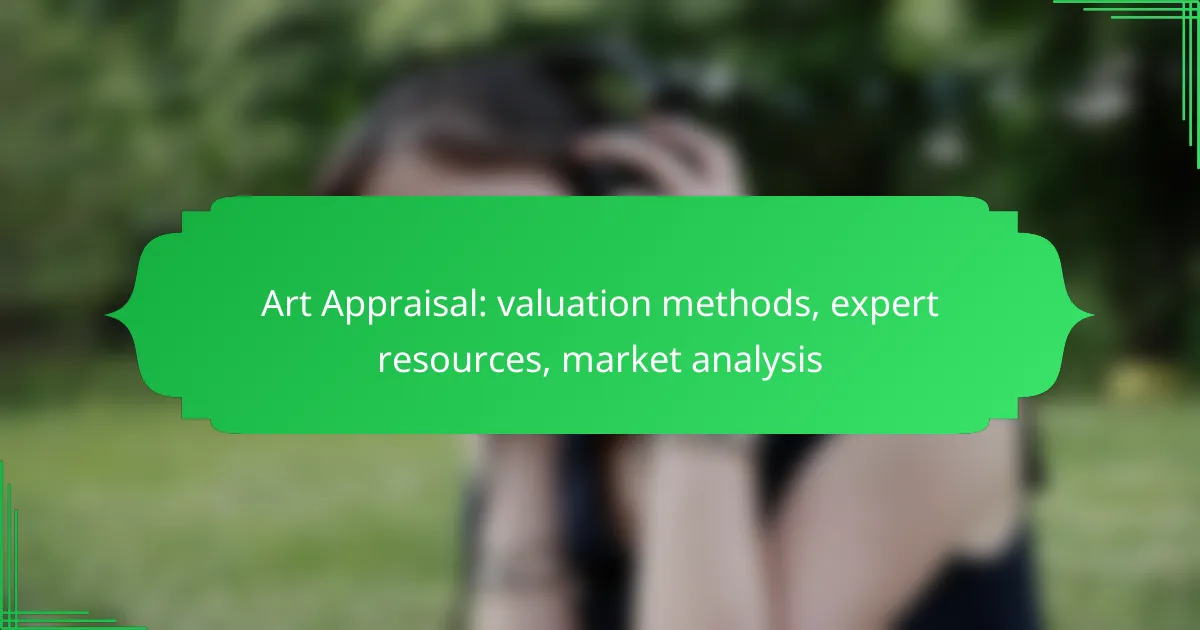Art appraisal is essential for understanding the value of artworks, employing various methods such as market analysis, comparative sales, and expert evaluations. Common valuation techniques include the cost approach, income approach, and sales comparison approach, each offering distinct insights based on production costs, income potential, and market trends. Leading experts in the field, including prestigious auction houses and independent professionals, leverage their extensive knowledge to deliver accurate appraisals, ensuring fair valuations for collectors and sellers alike.

How is art appraised in the UK?
Art appraisal in the UK involves determining the value of artworks through various methods, including market analysis, comparative sales, and expert evaluations. These approaches help collectors, sellers, and insurers understand the worth of art pieces in the current market.
Market value assessment
Market value assessment focuses on the price that a piece of art would likely fetch in a competitive sale. This method considers recent sales of similar artworks, current demand, and trends within the art market. Factors such as the artist’s reputation, the artwork’s provenance, and its condition also play significant roles.
To conduct a market value assessment, appraisers often consult auction results, gallery sales, and online platforms. It’s essential to keep in mind that market values can fluctuate, so regular updates are advisable for accurate valuations.
Comparative sales analysis
Comparative sales analysis involves examining the sale prices of artworks that are similar in style, medium, and artist. This method helps establish a benchmark for valuing a specific piece based on historical data. Appraisers typically look for comparable sales within a recent timeframe to ensure relevance.
When performing a comparative sales analysis, consider factors such as the size of the artwork, its condition, and any unique features that may affect its value. A well-documented list of comparable sales can provide a solid foundation for the appraisal process.
Expert opinion evaluation
Expert opinion evaluation relies on the insights of seasoned art appraisers or specialists who have extensive knowledge of specific art markets. These experts can provide valuable context and subjective assessments that quantitative methods may overlook. Their experience with similar artworks can guide accurate valuations.
When seeking expert opinions, it’s advisable to choose appraisers who are accredited by recognized organizations, such as the Royal Institution of Chartered Surveyors (RICS) or the Appraisers Association of America. This ensures credibility and adherence to professional standards in the appraisal process.

What are the common valuation methods for art?
The common valuation methods for art include the cost approach, income approach, and sales comparison approach. Each method offers a unique perspective on determining an artwork’s value based on different factors such as production costs, potential income generation, and market sales data.
Cost approach
The cost approach estimates the value of an artwork based on the costs incurred to create it, including materials, labor, and overhead. This method is particularly useful for contemporary art where the artist’s process and expenses can be clearly defined.
To apply this method, assess the total costs involved in the creation of the artwork and consider any depreciation that may affect its current value. For instance, if a painting took several months to create and involved high-quality materials, the valuation might reflect those significant costs.
Income approach
The income approach values art based on the potential income it can generate, such as through exhibitions, rentals, or resale. This method is often used for investment-grade art, where future earnings are a key consideration.
To utilize this approach, estimate the expected income streams from the artwork and apply a capitalization rate to determine its present value. For example, if an artwork is expected to generate annual income of USD 5,000 with a capitalization rate of 10%, its value would be approximately USD 50,000.
Sales comparison approach
The sales comparison approach involves comparing the artwork to similar pieces that have recently sold in the market. This method relies heavily on market data and is commonly used for valuing established artists’ works.
To implement this approach, gather data on recent sales of comparable artworks, adjusting for differences in size, condition, and provenance. For instance, if a similar painting sold for EUR 20,000, and your artwork has a similar profile but is slightly larger, you might adjust the value upward based on that size difference.

Who are the top art appraisal experts in the UK?
The top art appraisal experts in the UK include renowned auction houses and independent professionals who specialize in valuing artworks. These experts utilize various methods and extensive market knowledge to provide accurate appraisals, ensuring that clients receive fair valuations for their art collections.
Christie’s appraisers
Christie’s is one of the leading auction houses globally and employs a team of highly qualified appraisers with expertise across various art categories. Their appraisers are often specialists in specific fields, such as contemporary art, old masters, or decorative arts, providing tailored valuations based on current market trends.
When seeking an appraisal from Christie’s, clients can expect a thorough evaluation process that includes provenance research, condition assessment, and market comparison. The fees for appraisals can vary, typically starting from a few hundred pounds, depending on the complexity and value of the artwork.
Sotheby’s experts
Sotheby’s is another prestigious auction house in the UK, known for its comprehensive appraisal services. Their experts are well-versed in both historical and contemporary art, offering insights that reflect the latest market dynamics. Sotheby’s appraisers often have academic backgrounds or extensive experience in the art world.
Clients can benefit from Sotheby’s extensive database of past auction results, which aids in establishing fair market value. Appraisal fees may range from several hundred to several thousand pounds, depending on the artwork’s significance and the depth of the appraisal required.
Independent appraisers
Independent art appraisers in the UK provide personalized services that can be more flexible than those offered by large auction houses. These professionals often hold certifications from recognized organizations, such as the Royal Institution of Chartered Surveyors (RICS) or the Appraisers Association of America.
When hiring an independent appraiser, it’s crucial to check their credentials and experience in the specific type of art being valued. Fees for independent appraisals can vary widely, typically ranging from £200 to £1,500, depending on the appraiser’s expertise and the artwork’s complexity.

What factors influence art market analysis?
Art market analysis is influenced by various factors, including the reputation of the artist, current market trends, and the condition of the artwork. Understanding these elements can help collectors and investors make informed decisions about art valuation and acquisition.
Artist reputation
The reputation of an artist plays a critical role in determining the value of their work. Established artists with a strong track record often command higher prices, while emerging artists may have more variable valuations. Factors such as exhibition history, critical acclaim, and previous auction results can significantly impact an artist’s standing in the market.
When assessing an artist’s reputation, consider their participation in prestigious galleries and art fairs, as well as their recognition by art critics and institutions. For example, works by artists featured in major museums or biennials typically have a higher market value.
Market trends
Market trends can greatly affect art valuations, as they reflect the current demand and interest in specific styles, periods, or mediums. Trends can shift due to cultural movements, economic conditions, or changes in collector preferences. Staying informed about these trends is essential for making sound investment decisions.
To gauge market trends, regularly review auction results, attend art fairs, and follow industry publications. For instance, if contemporary art is gaining popularity, it may be a good time to invest in emerging artists within that genre.
Condition of the artwork
The condition of an artwork is a crucial factor in its valuation. Pieces that are well-preserved, free from damage, and properly authenticated tend to fetch higher prices. Conversely, artworks with significant wear, restoration, or provenance issues may see their value diminished.
When evaluating an artwork’s condition, consider factors such as surface damage, fading, and the quality of any repairs. It is advisable to obtain a professional appraisal or condition report to accurately assess these aspects before making a purchase.

What are the prerequisites for art appraisal?
Art appraisal requires a thorough understanding of the artwork’s history, condition, and market value. Key prerequisites include documentation of provenance and detailed condition reports to ensure accurate valuation.
Documentation of provenance
Provenance refers to the history of ownership of an artwork, which is crucial for establishing its authenticity and value. A well-documented provenance can significantly enhance an artwork’s market appeal and price, as collectors often seek pieces with clear and reputable histories.
To gather provenance information, collectors should look for records such as previous sales receipts, exhibition catalogs, and any relevant auction house documentation. This information can help trace the artwork’s journey through various owners and exhibitions, providing context that can influence its valuation.
Condition reports
Condition reports assess the physical state of an artwork, detailing any damage, restoration, or deterioration. These reports are essential for appraisers to determine the artwork’s current market value, as condition can greatly affect desirability and pricing.
When preparing a condition report, it is important to include high-quality photographs and a detailed description of any issues, such as cracks, fading, or repairs. Regular updates to these reports are advisable, especially if the artwork is displayed or transported frequently, as conditions can change over time.
